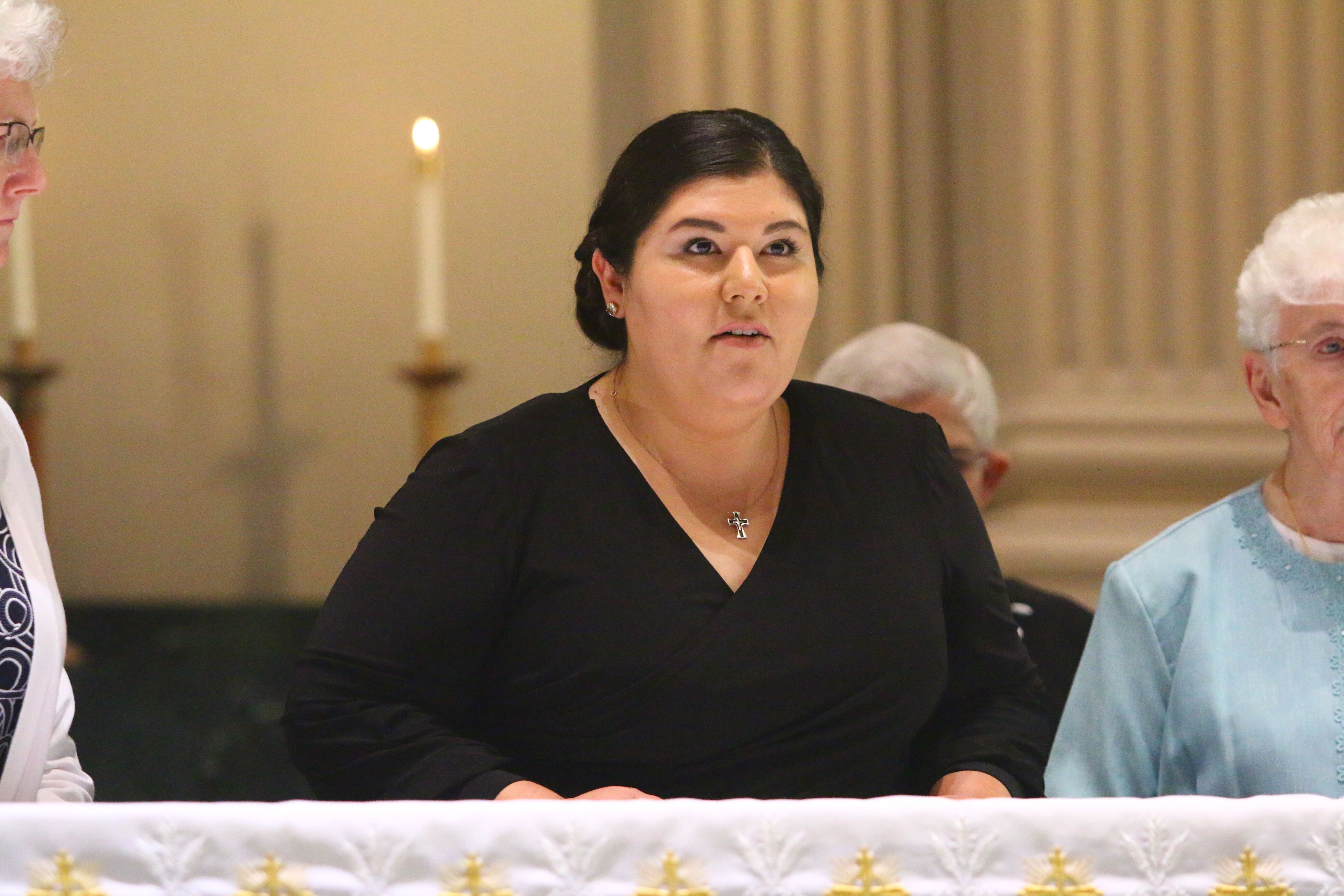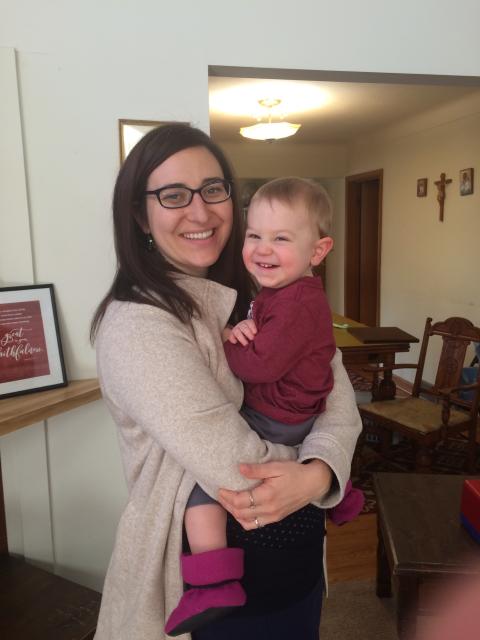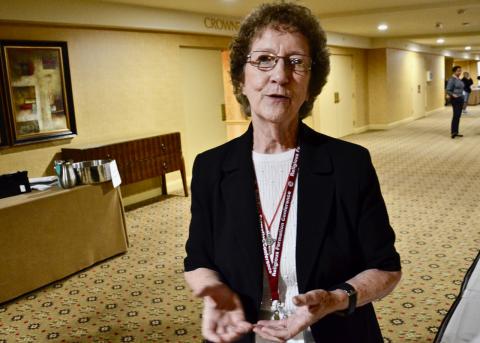
Sr. Margie Tapia, a geriatric nurse practitioner, signs her vows to become a permanent member of the Sisters of Mercy of the Americas on June 8, 2019. Three other Sisters of Mercy also made permanent vows that day. (Courtesy of the Sisters of Mercy of the Americas)
Nataleigh Waters-Lang was so certain she was going to join the Dominican Sisters of Mary, Mother of the Eucharist that when she met a member of the Religious Sisters of Mercy of Alma, she wrote in her journal, "I wish I could be an RSM, but I'm going to be a Dominican."
On Dec. 17, Waters-Lang, 30, leaves for Germany to enter the Religious Sisters of Mercy's pre-postulancy program, and that 2012 journal entry was just one more stop on a long journey to religious life. In between, she also considered joining the Carmelites and the Handmaids of the Sacred Heart of Jesus. There were even a few years when she was sure she wouldn't enter religious life at all.
"It's been like a 10-year process," Waters-Lang said. "It was just a series of serendipitous events."
Creating those serendipitous events is the focus of vocation teams, whose efforts are aimed at drawing younger women into religious life. With 80 percent of women religious in the United States age 70 or older, and 45 percent 80 or older, according to Leadership Conference of Women Religious figures, attracting younger women is critical.
But those efforts can't be a recruiting drive, warned Sr. Deborah Borneman, director of mission integration for the National Religious Vocation Conference (NRVC) and a member of the Sisters of Sts. Cyril and Methodius.
"We need to open it up so [our vocation effort] isn't just sisters and brothers and priests, and it's not just for my community," Borneman said. "A 'Yes!' is a yes to the church. …Aren't we all called to be radical disciples of Jesus? You may live a vowed life of marriage, I live a vowed life of community – it's not that one is higher than or lower than, it's a dignity of differences."
According to an analysis of annual reports by the Center for Applied Research in the Apostolate at Georgetown University, from 2015 to 2018, an average of 211 women entered religious life each year in the U.S. Their median age was 26; an average of 48 percent of them were 25 or younger.
Sixty-two percent of the 844 women joining religious life in that time period joined orders represented by the Conference of Major Superiors of Women Religious, 26 percent joined those in the Leadership Conference of Women Religious and 12 percent joined contemplative orders, CARA reported.
How to invite more young women to consider religious life is a question many communities and organizations are asking.
One key is exposure, said Rachel Harkins Ullmann, executive director of the GIVEN Institute, which organized the GIVEN Catholic Young Women's Leadership Forum in 2016 and 2019, and is planning the 2020 GIVEN Forum for Washington, D.C. The forums are designed to help young women develop their leadership gifts, but they also put young women in close contact with women religious for five days.
At least eight women who have attended GIVEN Forums, including Waters-Lang, have entered religious life, Ullmann said.
While children in Catholic schools may not have sisters as teachers like they did in the past, Ullmann said that's not critical, because that's no longer when young women are considering religious life. Rather, it's when they're in college that they are figuring out who they are and what they want to do, meaning that's where sisters need to be.
"Exposure to religious life is necessary for younger women to even consider a vocation," she said. "So many college campuses are set up with priest chaplains, but many if not most don't have a sister there. Colleges should really consider incorporating sisters into campus leadership roles."
Sr. Ann Oestreich, National Coordinator of the National Catholic Sisters Project, said that exposure, even in middle school, is helpful, even if girls are not thinking about the rest of their lives at the time.
"They have to see it's a viable choice, it's not just history," said Oestreich, a member of the Sisters, Servants of the Immaculate Heart of Mary. "It helps if younger women see sisters around, even if it's not in their schools, they need to see them in their parishes, in their neighborhoods. …It's visibility, visibility, visibility."

Pictured right to left are Sisters Marybeth Beretta, RSM, the president of an all-girls Catholic high school; Jennifer Barrow, RSM, an attorney in Brooklyn, New York; Danielle Gagnon, RSM, a development consultant; and Marjorie Tapia, RSM, a geriatric nurse practitioner. These women religious became permanent members of the Sisters of Mercy of the Americas, one of the largest congregations of Catholic sisters in the United States, on June 8, 2019. (Courtesy of Sisters of Mercy of the Americas.)
In addition to organizing National Catholic Sisters Week for the last six years, the National Catholic Sisters Project has developed a curriculum for middle and high school students that teachers can download for free. Six units are complete and translation into Spanish of the final two units is under way. The curriculum can be found here, but will be moving to a new website in January.
Oestreich said laypeople have many options to connect with sisters, such as associate programs, mission trips and volunteer work, which provide great exposure, but more importantly can draw people closer to God.
"The charism is never limited to those who took perpetual vows," she said. "We just have to keep doing what we're doing: Living lives that are visible, credible, inspiring and genuine, and being present to young women and men and their parents."
Ullman said mission trips can be fertile ground for drawing young people, while come-and-see weekends can easily feel a bit forced.
"[On mission trips] they actually get to work alongside sisters and see their joy and see the true return on the investment of giving up yourself in service to others," Ullman said. "You see men and women religious, they're in the jungle and they don't have air conditioning and they're happy. They eat rice and beans everyday and they're happy."
Sr. Jessica Kerber, who last year took final vows with the Handmaids of the Sacred Heart of Jesus, is in campus ministry at St. Joseph's University in Philadelphia. She said it's vital that young women get to know sisters.
Advertisement
"When they get to know you, it's like, 'Oh, that's a legitimate option,' " Kerber said. "She's normal and fun and doesn't have gray hair … yet."
She said it's easy to think of religious life as completely foreign, and many young women are surprised to find sisters can relate to what's going on in their lives. While religious life is a radical choice, when young women get to know sisters they find it may not be as radically different as they imagine.
"They're like, 'We just want to hear your stories,' " Kerber said. "They know they can approach us and have a conversation."
That is what drew Sr. Margie Tapia to the Mid-Atlantic Community of the Sisters of Mercy of the Americas.
"They were real," said Tapia, 33, who with three other younger women took final vows in June. "Their world was really attractive to me."
Tapia first met the Sisters of Mercy at her all-girls Catholic school in Watchung, New Jersey, and in high school volunteered at the sisters' retirement facility. While earning a nursing degree at Boston College, she became a Mercy Associate. Now she has a master's degree in nursing from New York University, is a doctoral candidate in nursing at Yale, and is director of health care and aging services for the Religious Teachers Filippini in Morristown, New Jersey.

Nataleigh Waters-Lang with her godson Giovanni. On Dec. 17, Waters-Lang leaves for Germany to enter the Religious Sisters of Mercy's pre-postulancy program. (Courtesy of Nataleigh Waters-Lang)
Tapia said she wasn't considering religious life when she got to know the Mercies in high school, but the Jesuit focus at Boston College on mission and service dovetailed with what she had learned from and about the sisters.
"I always felt at home in Mercy," she said. "I would come back to New Jersey (from college), and my time would be divided between family, friends and the sisters I had formed relationships with."
Many say that reaching younger women requires genuine encounters. The way to do that, said Sr. Nicole Trahan, a member of the Daughters of Mary Immaculate (Marianist Sisters), is to focus on helping people discover what God wants for them, whether it is religious life or something else.
"I don't think about it as recruiting," Trahan said. "I help people explore the possibilities of their life and how God is leading them."
Trahan said a woman discerned with the Marianists for four years before ultimately joining another community, and the woman later said she felt awkward about the situation.
"I said, 'You shouldn't. I did my job, which is to help you discern no matter where God is calling you,' " Trahan said.
Sr. Ruth Lubbers, a Sister of Notre Dame in Covington, Kentucky, said her vocation team's focus is not recruiting new members. The order has started a pilot mentoring program, she said, that uses 10 sisters and four associates to journey with young adults and energize their prayer lives.

Sr. Miriam Mitchell, of the Sisters of the Holy Spirit and Mary Immaculate in San Antonio, Texas, explains the community's plans for a young adult mentoring program called the Young Adult Spiritual Companions. Mitchell was speaking at the National Religious Vocation Conference in Louisville, Kentucky, October 26, 2019. (GSR photo/Dan Stockman)
"We are both vocation and young adult ministry," Lubbers said. "We're reaching out to young adults to help in their journey towards God. … We don't do this just to attract new members, we do it do let them know they have a place in the church, that they're valued and we care about them."
The Sisters of the Holy Spirit and Mary Immaculate in San Antonio, Texas, are also starting a mentoring program, said Sr. Miriam Mitchell, called the Young Adult Spiritual Companions.
Young people "are searching for something," Mitchell said. "They don't necessarily want to become sisters, priests or brothers, but they want some kind of prayer life, they want community with each other and they want to participate in the charism of the community."
She said it will be similar in some ways to an associate program, as it will have a six-month formation period and one-year renewable commitments, but is more focused on the spiritual life of the participants than anything else.
"We want to meet young adults where they are, people who want to be part of something bigger than themselves," Mitchell said.
Borneman said it's important not to see vocation numbers as validation of a community.
"We get into sister shaming," Borneman said. "We say, 'If you'd only do this. If you'd only pray this way or dress this way …' We act as if [vocations are] a reward or a lack of vocations is a punishment. There are certain things we can do to be present to our young adults, but we can't force them into it."
It might seem that building a relationship with a young woman would require being a young woman, and that older sisters may have a disadvantage. But Lubbers said that's not the case, and that being in her 70s allows her to offer different perspectives that younger women appreciate.
"I've see the many different faces of religious life," she said. "I've seen the different history and practices."
"We're reaching out to young adults to help in their journey towards God. We don't do this just to attract new members, we do it do let them know they have a place in the church, that they're valued and we care about them."
—Sr. Ruth Lubbers
But to reach young people, you have to go where young people are, so Borneman spent three days at the recent National Catholic Youth Conference in Indianapolis.
"We have a gathering space to meet sisters and priests," she said via telephone while at the conference. "Today, we're handing out crucifixes. But I don't ask, 'Are you considering religious life?' I ask if they've been thinking about life after high school and see where the conversation leads."
To get a better understanding of what leads people into religious life, the NRVC is working with CARA to update a landmark study on new vocations.
In 2009, they tried to survey every person who joined religious life from 1993 to 2008. The new study examines new vocations from 2003 to 2018 and also includes questions about living interculturally and intergenerationally.
The study is designed to examine what attracts and sustains membership, outline the challenges and opportunities for vocation ministers and to identify trends and best practices in promoting vocations and discernment. It is set for release Feb. 2, 2020, the World Day for Consecrated Life.
Vocation efforts need to be to invite people to religious life, not just a particular congregation, she said. All of the orders Waters-Lang considered should count their efforts a success.
"We can't manufacture or manipulate or purchase vocations," Borneman said. "You can have the best vocation director providing the best discernment events, but nothing's going to guarantee seekers are going to come to them. And if they do, nothing guarantees they're going to enter your religious institute. God calls, we respond. God recruits, we invite."
[Dan Stockman is national correspondent for Global Sisters Report. Follow him on Twitter @DanStockman or on Facebook.]








